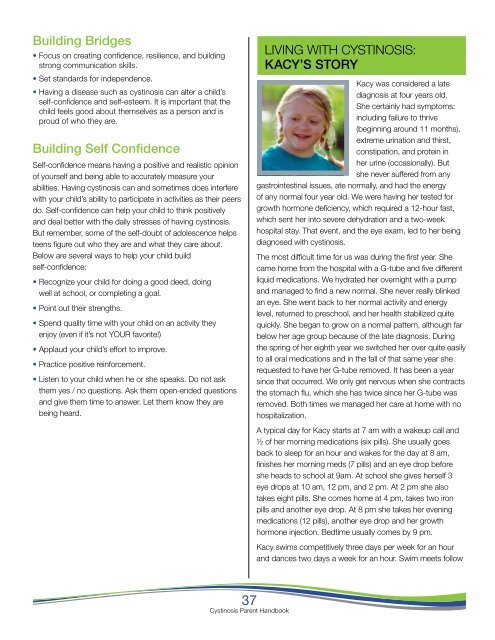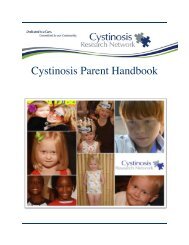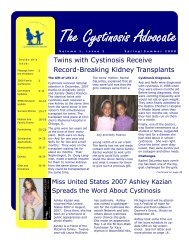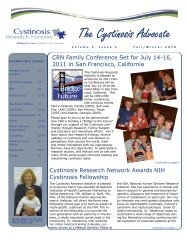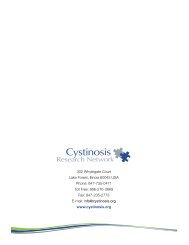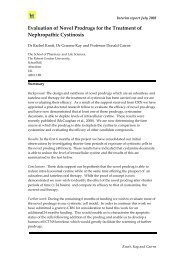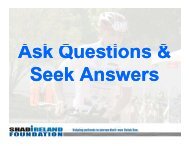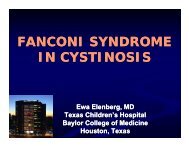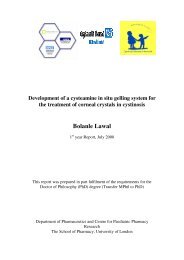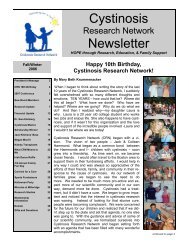School IssuesUnderstanding cystinosis will help your school systemunderstand your child or teen. The school may not have theintimate understanding that parents do, but having a clearand accurate idea of the impact of the illness will help theschool and district serve your child’s needs.<strong>Parent</strong>s should not be intimidated by the “educationalprofessionals”, and the school administrators should NOTbe intimidated by parents! Families should be clear, calm,and diplomatic in interactions with school and district staff.It is best to work as a team. However, parents should notlet teachers, support staff, or administrators tell them that arequest is “impossible.” An individual with cystinosis has aright to have his or her educational needs met.Some (but not all) children with cystinosis may haveparticular learning problems with visual processing, math,and spelling [30], [34] There are alternate ways to teachalmost everything! Some children will need full evaluations(Individualized Education Programs or IEPs) for specialeducation services; some will need tutoring or more time tofinish tasks. Some will need 504 plans (a documented needfor special accommodations in accordance with Section 504of the Rehabilitation Act and the Americans with DisabilitiesAct) so they can receive medications in school, or haveaccess to water or the bathroom, when they need it.Communication Is Key<strong>Parent</strong>s should get to know key individuals – including achild’s principal, guidance counselor, nurse, psychologist,social worker, AND ALL teachers (including those who teachspecial classes like art and physical education) as soon asthe school year begins. The principal should be asked todesignate a “point person” within the school as someonewho can be approached when questions arise. For medicalissues, this will likely be a nurse. For academic issues, it willlikely be a guidance counselor or school social worker. Keepin mind that some teachers may be more helpful than others.Provide the school with a packet of information aboutcystinosis. There are numerous helpful resources, pamphlets,and articles at: http://www.<strong>Cystinosis</strong>.org/what-is-<strong>Cystinosis</strong>/resources/educationIf a child is having cognitive or learning difficulties, parentsshould ask for a school evaluation, but also speak withmedical experts about what might be happening? If a childwith cystinosis is not able to attend school for an extendedperiod of time due to health issues, there are options forquality home instruction (though it is often advisable to keep itas short as possible) There may be technology that will allowa student to be in the classroom “virtually” during extendedperiods of absence.Checklists for school age children, Ages 6 - 12<strong>Parent</strong>/Caregiver Checklists SchoolAge Children Ages 6 - 12• Meet with the school staff in the spring of every schoolyear to review your child’s IEP and 504 plans andimplement any necessary changes.• Meet with the school nurse and staff at the start of theschool year. Bring handouts from the CRN website anddiscuss your child’s individual needs for water, frequentbathroom breaks, medications, and eye drops.• Help your child to become more independent with selfcare.Just as they learn to do chores around the houseduring the school-age years, your child should also startto learn how to care for themselves. Have your childhelp prepare weekly / daily medications. Discuss thepurpose of each medication with your child. If parents canhelp their child to grow toward complete self-care as aprocess over several years, it can be an easier transitionfor the adolescent or young adult to completely care forthemselves when going to college or moving out andgetting a job or starting a career.Child Checklists School AgeChildren, Ages 6 - 12School age years are all about learning and speaking up foroneself. In addition to the preschool expectations, the schoolage child should be expected to:• Know the dose, time and correct use of medications.• With the help of an adult, seek ways to remembermedicines. For example, have a daily routine, such astaking morning medications with breakfast, and eveningmedications with dinner and/or at bedtime.• Discuss treatment of symptoms with parents.• Learn to quickly identify signs that you are not feeling well.36<strong>Cystinosis</strong> <strong>Parent</strong> <strong>Handbook</strong>
Building Bridges• Focus on creating confidence, resilience, and buildingstrong communication skills.• Set standards for independence.• Having a disease such as cystinosis can alter a child’sself-confidence and self-esteem. It is important that thechild feels good about themselves as a person and isproud of who they are.Building Self ConfidenceSelf-confidence means having a positive and realistic opinionof yourself and being able to accurately measure yourabilities. Having cystinosis can and sometimes does interferewith your child’s ability to participate in activities as their peersdo. Self-confidence can help your child to think positivelyand deal better with the daily stresses of having cystinosis.But remember, some of the self-doubt of adolescence helpsteens figure out who they are and what they care about.Below are several ways to help your child buildself-confidence:• Recognize your child for doing a good deed, doingwell at school, or completing a goal.• Point out their strengths.• Spend quality time with your child on an activity theyenjoy (even if it’s not YOUR favorite!)• Applaud your child’s effort to improve.• Practice positive reinforcement.• Listen to your child when he or she speaks. Do not askthem yes / no questions. Ask them open-ended questionsand give them time to answer. Let them know they arebeing heard.Living with <strong>Cystinosis</strong>:Kacy’s StoryKacy was considered a latediagnosis at four years old.She certainly had symptoms:including failure to thrive(beginning around 11 months),extreme urination and thirst,constipation, and protein inher urine (occasionally). Butshe never suffered from anygastrointestinal issues, ate normally, and had the energyof any normal four year old. We were having her tested forgrowth hormone deficiency, which required a 12-hour fast,which sent her into severe dehydration and a two-weekhospital stay. That event, and the eye exam, led to her beingdiagnosed with cystinosis.The most difficult time for us was during the first year. Shecame home from the hospital with a G-tube and five differentliquid medications. We hydrated her overnight with a pumpand managed to find a new normal. She never really blinkedan eye. She went back to her normal activity and energylevel, returned to preschool, and her health stabilized quitequickly. She began to grow on a normal pattern, although farbelow her age group because of the late diagnosis. Duringthe spring of her eighth year we switched her over quite easilyto all oral medications and in the fall of that same year sherequested to have her G-tube removed. It has been a yearsince that occurred. We only get nervous when she contractsthe stomach flu, which she has twice since her G-tube wasremoved. Both times we managed her care at home with nohospitalization.A typical day for Kacy starts at 7 am with a wakeup call and½ of her morning medications (six pills). She usually goesback to sleep for an hour and wakes for the day at 8 am,finishes her morning meds (7 pills) and an eye drop beforeshe heads to school at 9am. At school she gives herself 3eye drops at 10 am, 12 pm, and 2 pm. At 2 pm she alsotakes eight pills. She comes home at 4 pm, takes two ironpills and another eye drop. At 8 pm she takes her eveningmedications (12 pills), another eye drop and her growthhormone injection. Bedtime usually comes by 9 pm.Kacy swims competitively three days per week for an hourand dances two days a week for an hour. Swim meets follow37<strong>Cystinosis</strong> <strong>Parent</strong> <strong>Handbook</strong>


